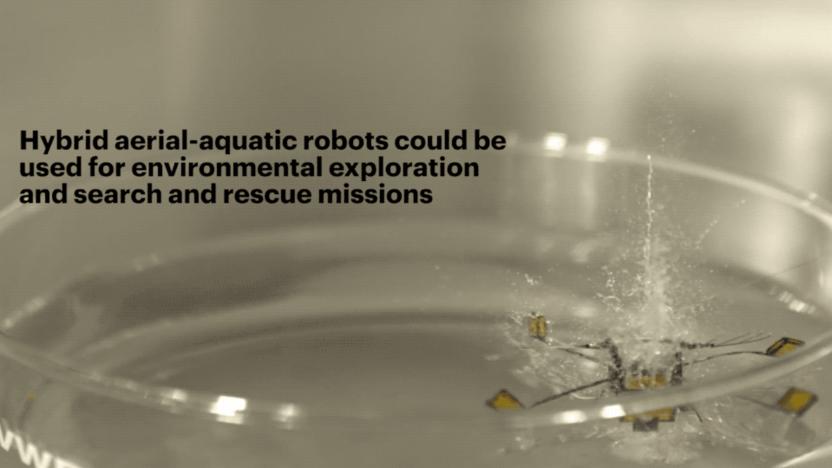robobee
Latest

Robot bees can crash into walls without taking damage
Tiny robotic fliers aren't exactly durable at present, but they may be tough critters before long. Harvard researchers have developed a RoboBee that uses soft, artificial muscles (really, actuators) to fly without taking damage. The robot can smack into walls, crash-land or even collide with fellow 'bees' without getting hurt. Soft-muscle fliers have existed before, but this is the first with enough power density and control to hover -- that is, it's not just flying wildly.

Harvard's new RoboBee can fly in and out of water
Apparently, we haven't seen RoboBee's final form yet. Harvard researchers introduced the robot back in 2013 and developed a version that uses static to stick to walls in 2016. Now, the scientists have created an upgraded robotic bee that can fly, dive into water and hop right back up into the air. That's a lot tougher than it sounds, since the tiny machine is only two centimeters tall and is about one-fifteenth the weight of a penny. For such a small robot, swimming in water is like swimming in molasses and breaking through the water's surface is akin to breaking through a brick wall.

Harvard's RoboBee uses static to stick to surfaces
Harvard's tiny robotic bee has learned how to stick to surfaces like Spiderman. Unlike spiders that use thousands of tiny hairs to climb walls, though, the upgraded RoboBee uses the power of static electricity. A team of engineers from both Harvard and MIT wanted to find a way for minuscule drones' batteries to last longer. Adding hairs or miscropines to their feet like what Stanford researchers did with their SCAMP robot wouldn't work for such tiny machines, though. So, the team decided to work with static electricity instead.

Six robots inspired by real-life animals
By Cat DiStasio Many scientific and engineering developments were lifted right out of nature, but none more so than robots built to act like real-life animals. Biomimicry is the term for innovations like these, which draw inspiration from the power of nature to solve the toughest human problems. Robots can take on some pretty unlikely tasks, from pollinating flowers as bee populations decline to detecting pollution in waterways. Other robots are designed purely for fun, like this 12-legged robot that walks like a crab and is powered by the sun.

Robotic bees outdo their organic rivals by swimming
Harvard's Robobees are already pretty adroit for paper-clip sized drones; they fly around stably in calm air and hover like real bees (if real bees were tethered to power). Researchers have given them a new talent that even the insects don't have -- the ability to "fly" underwater. To do so, they make like ducks and transition from flight to swimming by crashing into the water, sinking a bit, then flapping their wings at a slower pace (9 Hz) than in the air (120 Hz) . That's already a feat that few drones can match, but the aim is to eventually build autonomous bots that could do search and rescue and other beneficial activities.

Harvard University's robotic insect takes its first controlled flight (video)
There's hardly a shortage of animal inspired robots, but few are as tiny as Harvard's autonomous RoboBee. The robotic insect has been around for a while, but researchers at the Wyss Institute for Biologically Inspired Engineering only recently managed a minor breakthrough: controlled flight. Using new manufacturing and design processes, the team has managed to keep the coin-sized bug aloft by independently manipulating the robot's wings with piezoelectric actuators and a delicate control system. "This is what I have been trying to do for literally the last 12 years," explains Professor Robert J Wood, Charles River Professor of Engineering and Applied Sciences. "Now that we've got this unique platform, there are dozens of tests that we're starting to do, including more aggressive control maneuvers and landing." There's more to be done, however. The tiny machine still requires a tether for power and control, and researchers are still studying nature to suss out how insects cope with flying through wind and the elements. Eventually, the team hopes to outfit the RoboBee with lightweight batteries, an internal control system and a lighter chassis. For now, however, they're just happy to learned to steer. Check out the insect in action after the break.

NSF awards Harvard $10 million for robot bees (video)
When we heard that the National Science Foundation awarded $10 million to Harvard to make a swarm of robot bees, our first thought was: "We could do it for half the price." Then we remembered that the university has been down this path before, including its robot fly program (whatever happened to that thing?) and might be the better choice after all. What does the NSF and Harvard hope to get for all that time and money? Aside from insight into such areas as distributed intelligence, robotic flight, and energy storage, a swarm of these bad boys could be tasked to do anything from battlefield spying to pollination (which might be necessary, with the way that real bees are vanishing at such an alarming rate). The RoboBee project is slated to run for the next five years. Video after the break. [Via Switched]




